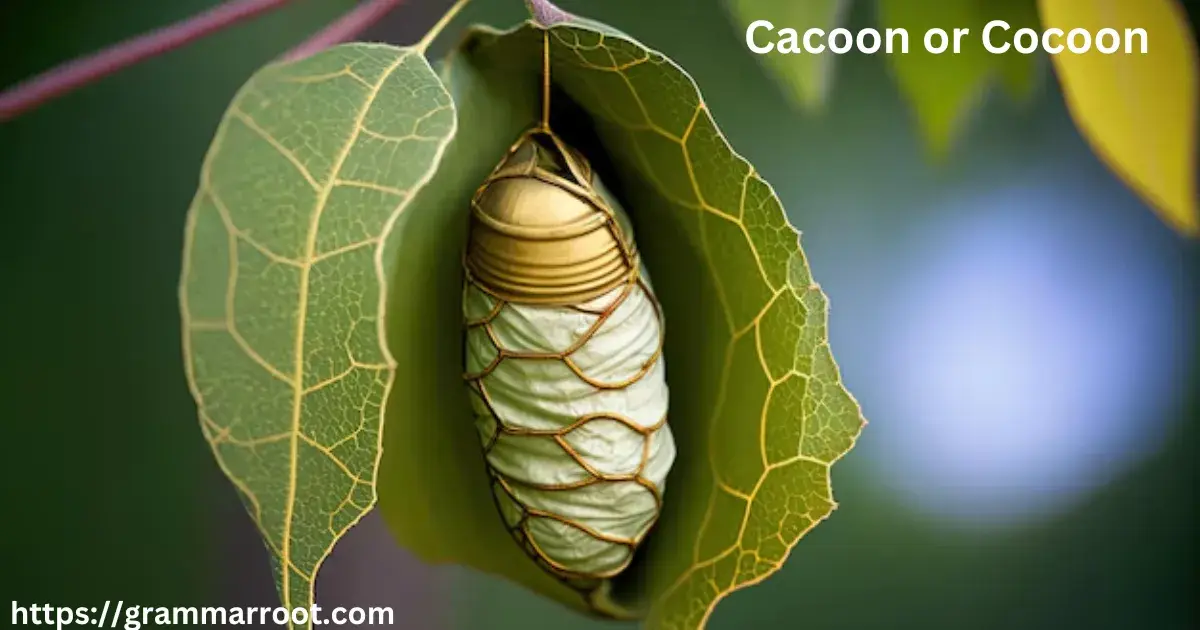In the English language, spelling mistakes are common, especially when two similar words are confused. One of the most frequent spelling errors is choosing between “cacoon” or “cocoon.” So, which one is correct? The answer is clear: “Cocoon” is the accurate and accepted spelling. However, the misspelling “cacoon” appears often, leading to confusion for writers and speakers alike. This article will explore the correct spelling, when and where to use it, and even highlight how spelling errors can creep into communication.
What is a Cocoon?
A cocoon is the protective casing or shell spun by an insect, particularly a butterfly or moth, during its metamorphosis. The cocoon serves as a safe haven for the insect as it undergoes a transformation. You might also encounter the word used metaphorically, referring to a state of seclusion or a protective environment where someone feels shielded from the outside world.
Let’s dive deeper into this issue, starting with the simple question: How do you spell cocoon?
How Do You Spell Cocoon?
The word is spelled C-O-C-O-O-N. It consists of two “o”s in the middle, flanked by the letters “c”, “o”, and “n”. So, if you’re ever unsure, just remember that the word begins with “co” and ends with “oon.” It’s easy once you break it down!
The Common Misspelling: Cacoon
The misspelling “cacoon” is a common error. It likely stems from confusion with other English words that use double vowels, such as “balloon” or “baboons,” which might lead someone to mistakenly double the “c.” Although this spelling isn’t correct, you’ll often encounter it, especially in informal writing or social media posts.
Scenario 1: Email Example Using the Correct Spelling (Cocoon)
Subject: Meeting Update – Cocoon Project Development
Dear Sarah,
I hope this email finds you well. I wanted to give you an update on the progress of the Cocoon project. We’ve made significant strides, and the prototype is now fully functional. Our team is excited about the next phase, where we will focus on testing the cocoon’s durability in real-world scenarios.
Please let me know if you have any questions. I’ll be happy to provide more details.
Best regards,
Jake
In this scenario, “cocoon” is used correctly to refer to a project that could be a physical object or a metaphorical idea (like a protective environment).
Scenario 2: Email Example Using the Incorrect Spelling (Cacoon)
Subject: Feedback on the Cacoon Concept
Hi Mark,
I wanted to quickly follow up with you regarding the Cacoon concept you shared last week. I think it’s a fantastic idea, but we might need to revisit some of the design aspects. For example, the structure and material choices may need to be adjusted to meet the required specifications.
Looking forward to your thoughts.
Kind regards,
Lily
Here, “cacoon” is misspelled, but the context still makes sense. It’s clear that the person refers to something similar to a cocoon, but using the incorrect spelling could confuse readers or seem unprofessional in formal communication.
Cocoon: A Versatile Word
The word “cocoon” can be used in various contexts, extending beyond just its literal meaning. Here are some different scenarios in which “cocoon” fits perfectly:
1. The Life Cycle of a Butterfly
As a cocoon is the protective shell for a butterfly during its metamorphosis, it can represent transformation and growth.
2. The Cocoon of Comfort
When you hear someone say, “I’m in my cocoon,” they may be describing a comfortable, sheltered state. It’s often used metaphorically to mean a state of isolation or personal space.
3. Cocoon Tent
A cocoon tent is a popular choice for camping. These tents are designed to be lightweight, offering a sense of comfort and protection—just like the natural cocoon.
Misuse of “Cacoon” in Popular Contexts
Let’s look at some common uses of cacoon in certain contexts, where people may incorrectly spell the word:
- Cacoon USA: This might be used to refer to a brand or company, though the correct term should still be cocoon.
- Cacoon Tent: Again, people might mistakenly use “cacoon” instead of the correct spelling, especially in product descriptions.
- Cacoon Double: This could be a reference to a type of swing or seating designed for two people. However, the correct term is cocoon double.
- Cacoon Swing: A cocoon swing is a relaxing chair that mimics the feeling of being enveloped in a cozy cocoon. Using cacoon here would be incorrect.
The Living in a Cocoon Metaphor
When people talk about living in a cocoon, they usually refer to a state of isolation or self-imposed seclusion. It suggests a need for personal growth or a period of retreat. For example:
“I’ve been living in a cocoon recently—just focusing on my work and personal growth. I’ll emerge when I’m ready.”
This metaphor draws on the concept of the cocoon as a protective and transformative space.
Key Points to Remember About Cocoon vs. Cacoon
- The correct spelling is cocoon, not cacoon.
- Cocoon refers to a protective covering spun by insects during metamorphosis, especially butterflies and moths.
- The term cocoon is often used metaphorically to describe a state of isolation or safety.
- Cacoon is an incorrect spelling often seen in casual writing.
- Cocoon tents are a type of camping gear designed for comfort and protection.
- Cacoon USA could be a misspelled brand name, though the proper name should be Cocoon.
- Cocoon swings are seating options that provide a comfortable, enclosed space for relaxation.
- Cacoon tent and cocoon tent are often used interchangeably, but the correct term is cocoon tent.
- Using “cacoon” instead of “cocoon” could appear unprofessional in formal writing.
- The metaphor of living in a cocoon often refers to a temporary period of self-imposed isolation.
- The cocoon metaphor also relates to personal growth and transformation.
- Avoid using cacoon in formal emails, reports, or professional settings.
- A cocoon can represent protection, growth, or a space for change.
- Double-check your spelling when writing about anything that could relate to metaphor, such as cocooning.
- Cocoon has both a literal and metaphorical meaning.
- When in doubt, always spell it cocoon.
- A cocoon swing provides a relaxing and secure environment for adults or children.
- Cacoon tends to appear mostly in informal settings like text messages or social media posts.
- Always ensure that the spelling of cocoon aligns with the intended meaning and context.
- Keep your writing professional by checking for such common spelling errors.
Conclusion
To sum it up, the correct spelling is “cocoon”, and it’s a word with both literal and figurative significance. The incorrect spelling “cacoon” is common but should be avoided in formal or professional writing. By being mindful of this small but important detail, your writing will not only be more accurate but also more credible.

Johan is an professional & experienced blogger passionate about language and writing on Grammar root. He shares his expertise in grammar, punctuation, and effective communication, making complex rules simple and accessible for readers. With a knack for clear explanations and engaging content, Steel aims to help others master the art of language.

